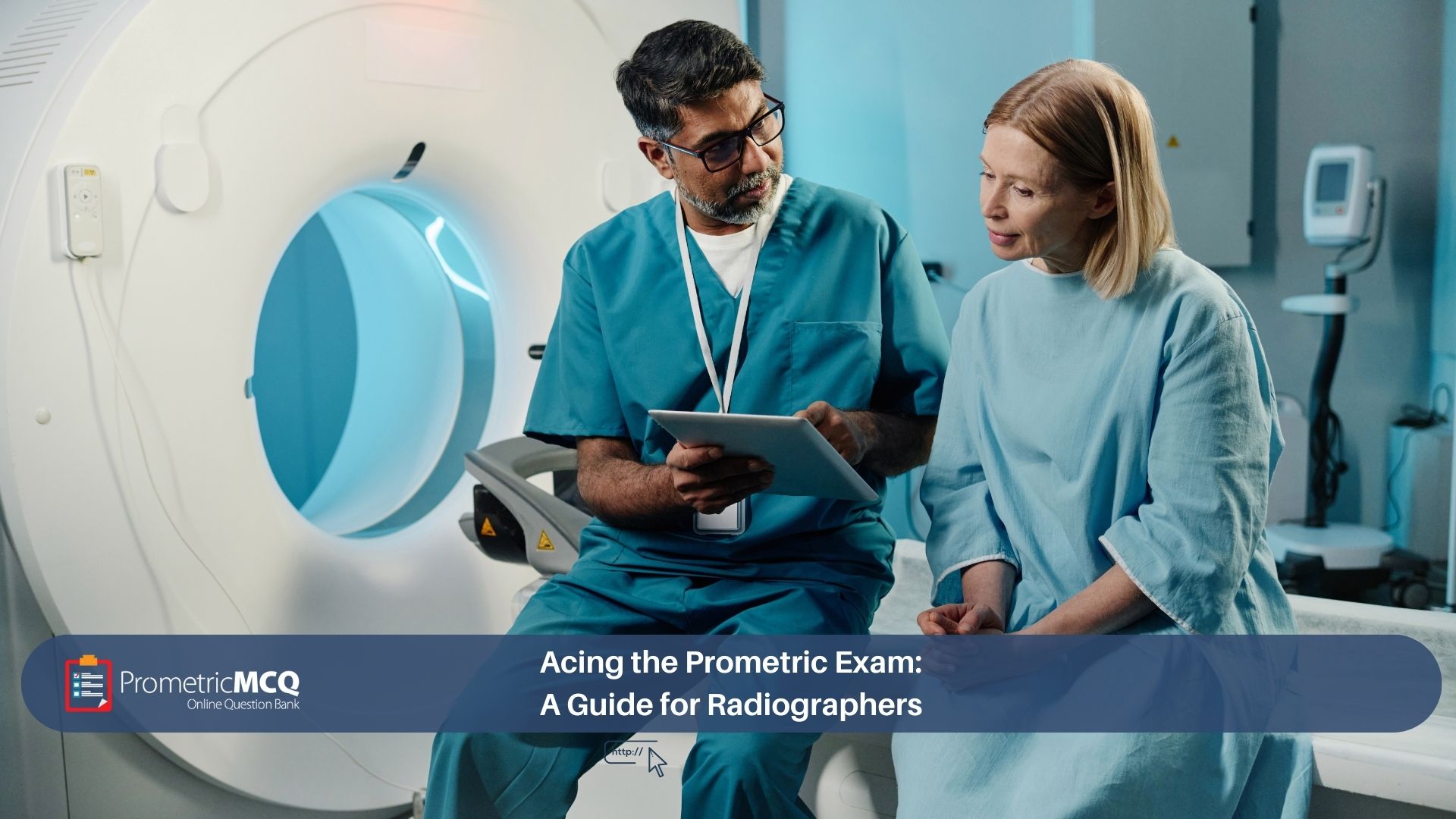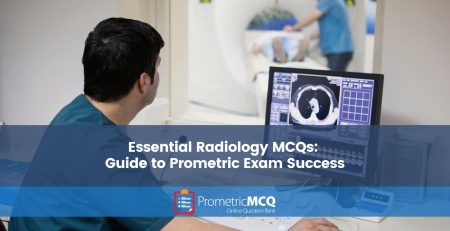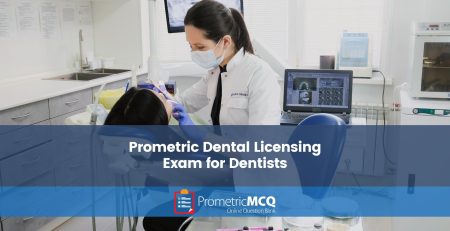
Acing the Prometric Exam: A Guide for Radiographers
fatima@prometricmcq.com2025-09-26T21:13:18+00:00Table of Contents
ToggleAcing the Prometric Exam: A Guide for Radiographers (2025)
Radiographers and radiologic technologists are the cornerstone of diagnostic medicine, providing the critical images that guide clinical decisions. For those seeking to practice their profession in the advanced healthcare systems of the Gulf region—be it in the UAE, Saudi Arabia, Qatar, Oman, or Bahrain—a significant milestone stands in the way: the Prometric licensing exam. Administered on behalf of health authorities like the DHA, MOH, and SCFHS, this exam is a rigorous test of your technical skills, theoretical knowledge, and unwavering commitment to patient safety.
This is not an exam that can be passed with superficial knowledge. The Prometric exam for radiographers is designed to simulate the challenges of a modern imaging department. It is a case-based assessment that will test your ability to execute complex positioning techniques, critique images for diagnostic quality, apply the principles of radiation physics, and, most importantly, ensure the safety of both patients and staff. Success requires a deep, integrated understanding of the entire imaging chain, from photon production to final image evaluation.
This ultimate 2025 guide is your comprehensive roadmap to acing the radiographer Prometric exam. We will dissect the exam’s universal pattern and provide a detailed breakdown of the high-yield syllabus topics. You will find a collection of realistic, exam-style Multiple-Choice Questions (MCQs) with exhaustive rationales to hone your critical thinking. Finally, a robust 10-point FAQ section will demystify the entire process, empowering you to create a winning study strategy and pass on your first attempt.
Key Takeaways for the Radiographer Exam
- Positioning is Paramount: A huge portion of the exam is dedicated to radiographic procedures. You must master standard and specialized views, including centering points and evaluation criteria.
- ALARA is a Philosophy: Radiation protection is not just a topic; it’s a theme that runs through the entire exam. Every decision should be viewed through the lens of safety.
- Master the Exposure Triangle: A deep understanding of how kVp, mAs, and SID interact to affect image quality (contrast, density, detail) and patient dose is essential.
- Image Critique is a Core Skill: You must be able to look at a radiograph and identify positioning, exposure, and artifact errors.
- Practice is Policy: The most effective study method is to solve hundreds of MCQs from a specialized question bank to master the application of knowledge.
Deconstructing the Prometric Radiographer Exam: Pattern and Syllabus
While the exam you take may be for a specific authority like the Saudi Prometric Exam for Radiographers, the fundamental pattern administered by Prometric is highly consistent across the region.
Core Exam Framework
- Administrator: Prometric
- Format: Computer-Based Test (CBT) with 100% MCQs.
- Structure: Typically 100-150 questions.
- Duration: Typically 2-3 hours.
- Scoring: A Pass/Fail result is given. The unofficial passing score is generally around 60%. There is no negative marking, so every question must be answered.
High-Yield Syllabus Breakdown
Your study plan should be built around the core competencies of a radiographer. The exam is designed to test these key domains comprehensively.
| Radiography Domain | High-Yield Topics and Key Concepts for 2025 |
|---|---|
| Radiographic Procedures & Patient Positioning (~40%) | This is the largest and most critical domain. It covers all standard projections for the skeletal system (extremities, spine, skull, facial bones), chest, and abdomen. You must know patient and part positioning, central ray (CR) location and angulation, collimation, and the specific anatomical structures demonstrated on each view. Special projections (e.g., sunrise view for patella, axiolateral hip) are also high-yield. |
| Image Production & Evaluation (~25%) | This domain covers the physics of how an image is created and what makes it diagnostic. Exposure Factors: kVp (contrast), mAs (density), SID, OID. Image Quality: Spatial resolution, distortion, and noise (quantum mottle). Image Receptors: Principles of DR, CR, and film-screen systems. Image Critique: Identifying and correcting positioning, motion, and exposure errors. |
| Radiation Protection (ALARA) (~20%) | This is a theme throughout the exam. Principles: Time, distance, and shielding. Patient Protection: Collimation, gonadal shielding, and communication. Personnel Protection: Dosimetry (TLDs, OSLs), protective apparel, and safe practices. Radiation Biology: Long-term and short-term effects of radiation (stochastic vs. deterministic). |
| Specialized Modalities & Equipment (~15%) | This section tests your foundational knowledge of other imaging areas. Fluoroscopy: Principles and safety. CT: Basic principles, terminology (e.g., pitch, windowing), and patient safety. MRI: Basic principles and, most importantly, MRI safety zones and screening. Mammography: Basic positioning. Equipment: X-ray tube components, grids, and quality control procedures. |
Free Prometric Radiographer Exam: Sample Questions and Answers
The best way to prepare is by applying your knowledge to exam-style questions. Analyze the following scenarios and their detailed rationales to understand the level of critical thinking required. For exhaustive practice, using a dedicated bank of Radiography MCQs is the most effective strategy.
Question 1: Radiographic Positioning
A patient is sent for a PA projection of the chest to evaluate the lungs. The patient is ambulatory but is complaining of shortness of breath. To minimize magnification of the heart shadow and obtain the sharpest image, what is the recommended Source-to-Image Distance (SID)?
- 40 inches (102 cm)
- 48 inches (122 cm)
- 60 inches (152 cm)
- 72 inches (183 cm)
Correct Answer: D (72 inches / 183 cm)
Rationale: This is a fundamental principle of chest radiography. A long SID is used for chest X-rays for two primary reasons. First, it minimizes the magnification of the heart, providing a more accurate representation of its true size. The heart is an anterior structure, and in a PA projection, it is farther from the image receptor, which would normally increase magnification; the long SID compensates for this. Second, a longer SID reduces geometric unsharpness and improves spatial resolution. The standard, universally accepted SID for a PA chest radiograph is 72 inches (183 cm).
Why other options are incorrect:
A: 40 inches is the standard SID for most general radiographic procedures (e.g., extremities, spine) but is too short for a PA chest.
B & C: While longer than 40 inches, these are not the standard SID and would still result in more cardiac magnification than is optimal.
Question 2: Image Production and Evaluation
A radiograph of the abdomen appears grainy and mottled (quantum mottle). This is most likely the result of which of the following?
- Excessive kVp
- Insufficient mAs
- Using a high-ratio grid
- A short SID
Correct Answer: B (Insufficient mAs)
Rationale: Quantum mottle, or radiographic noise, has a grainy, salt-and-pepper appearance. It is caused by an insufficient number of photons reaching the image receptor to form the image. The primary controlling factor for the quantity of photons (and thus, the radiographic density) is mAs. When the mAs is set too low for the body part being imaged, the result is a noisy, under-exposed image. The solution is to increase the mAs.
Why other options are incorrect:
A: Excessive kVp would result in an image with low contrast (many shades of gray), but not necessarily noise.
C: A high-ratio grid is used to clean up scatter and improve contrast. If used improperly without a corresponding increase in mAs, it could lead to an underexposed and noisy image, but the root cause is still the insufficient photon quantity (mAs).
D: A short SID would increase the intensity of the beam reaching the receptor, which would prevent, not cause, quantum mottle.
Question 3: Radiation Protection
Which of the following radiation protection principles is the most effective method for reducing occupational exposure to a radiographer during a fluoroscopy procedure?
- Time
- Shielding
- Distance
- Collimation
Correct Answer: C (Distance)
Rationale: This question tests your understanding of the cardinal principles of radiation protection. While all are important, distance is the single most effective factor. Radiation exposure decreases dramatically with distance from the source, following the Inverse Square Law (intensity is inversely proportional to the square of the distance). Doubling your distance from the patient (the primary source of scatter radiation in fluoroscopy) reduces your exposure by a factor of four. Taking even one step back from the table during an exposure has a massive impact on dose reduction.
Why other options are incorrect:
A: Limiting the fluoroscopy time is crucial for patient dose but may not always be controllable by the radiographer.
B: Wearing a lead apron (shielding) is mandatory and essential, but it only protects the parts of the body it covers. Distance protects the entire body, including the lens of the eye.
D: Collimation is a key principle for reducing patient dose and scatter, but its primary effect is on the patient, with a secondary effect on staff exposure.
Frequently Asked Questions (FAQs) for the Radiographer Exam
The exam result is strictly Pass/Fail. The licensing authorities do not provide a numerical score. Based on candidate feedback and expert analysis, the unofficial passing threshold is estimated to be around 60%. It is wise to aim for a consistent score of 70% or higher on practice tests.
The core content is highly similar as they are all based on international standards of radiography practice. The primary difference might be a slight variation in the number of questions on specialized modalities or a different emphasis on certain procedures. However, a candidate who is well-prepared for one exam (e.g., the SCFHS Radiographer exam) will be well-prepared for all of them.
You do not need to be a physicist, but you must have a strong practical understanding of applied physics. You need to know how changing kVp and mAs affects the image and the patient, the principles of scatter, and the basics of how an x-ray tube works. The questions will be applied and conceptual, not pure physics theory.
No, you do not need to memorize exact kVp/mAs charts. Instead, you need to understand the relative differences. For example, you should know that a lateral lumbar spine requires significantly more mAs than an AP lumbar spine, and that an abdomen requires a lower kVp than a chest X-ray to achieve good subject contrast.
No, the exam is vendor-neutral. It tests your knowledge of the principles of radiographic equipment (e.g., anode heel effect, grid function), not the specific operation of a GE, Siemens, or Philips machine.
Primary Source Verification (PSV) is a mandatory credential check by a company called DataFlow. They will verify your radiography degree, professional license, and work experience directly with the issuing institutions. A positive report is required before your license can be issued.
While a good textbook like *Merrill’s Atlas of Radiographic Positioning & Procedures* is essential for reference, the most effective way to learn for the exam is through active recall. Use a QBank with image-based questions that asks you to identify the projection, critique the positioning, or name the demonstrated anatomy. The American Society of Radiologic Technologists (ASRT) also provides excellent professional resources.
No, the exam is closed-book. You cannot bring any personal items into the testing room. An on-screen calculator will be provided by the Prometric software for any questions that might require it, although complex calculations are rare on the radiographer exam.
Most health authorities allow three attempts to pass the exam. A waiting period is typically required between attempts. A failure should prompt a serious re-evaluation of your study methods, likely shifting towards a more intensive, question-based practice regimen.
The final week is for consolidation, not cramming. Review your notes on key positioning criteria, radiation safety principles, and exposure factor relationships. Do one or two full-length timed mock exams to perfect your pacing. In the 48 hours before the test, prioritize sleep and relaxation to ensure you are mentally sharp.
Conclusion: Your Path to a Career in Medical Imaging
The Prometric exam for radiographers is a comprehensive test of the skills that define a competent and safe practitioner. It is a challenging but fair assessment that rewards a deep understanding of procedures, physics, and protection. By building your preparation on a foundation of active, question-based learning and by mastering the high-yield topics outlined in this guide, you can approach your exam with confidence. Passing this test is the critical step to launching a rewarding career in one of the world’s most dynamic and advanced healthcare environments.
Ready to Turn Your Preparation into a Passing Score?
Our comprehensive Radiography MCQ packages are filled with high-yield questions on positioning, image evaluation, and radiation safety, complete with detailed rationales and simulated exams to guarantee your success.










